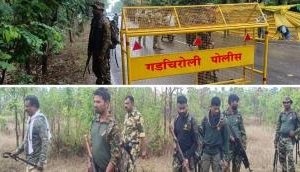We're damned! Only 7% of large Indian dams have emergency action plans
_73881_730x419-m.jpg)
As floods continue to wreak havoc in various parts of India, the Comptroller and Auditor General (CAG) has come out with a damning report on the safety of 4,862 large dams built on various rivers.
In its scathing report on Schemes for Flood Control and Flood Forecasting, the CAG pointed out that less than 7% of the total dams in India have operation and maintenance manuals, and Emergency Action Plans (EAPs)/Disaster Management Plans, which help in mitigating loss of human lives and destruction of property downstream if a dam fails.
The National Register of Large Dams, 2002, claimed the existence of about 4,050 completed large dams in India, while 475 were still under construction. As of March 2016, the number of large dams has increased to 4,862, but the National Register made a shocking claim that EAPs were not available for most of the completed large dams.
What is EAP?
The EAP is a formal document that identifies potential emergency conditions at a dam, and specifies pre-planned actions to be followed to minimise property damage and loss of life.
According to the CAG report: “The effect of such a disaster can be mitigated to a great extent if the resultant magnitude of flood peak and its time of arrival at different locations downstream of the dam can be estimated, thereby facilitating the planning of emergency action measures.”
The main components of EAPs include:
- Determination of the potential inundated area by dam break analysis
- Preparation of inundation maps
- Notification of emergency
- Communication, flood management
- Evacuation, which help in reducing the damage caused by floods caused by dam fails.
“Out of 4,862 large dams, EAP/DMPs of only 349 large dams (7%) were prepared (March 2016). Preparation of action plans to implement EAPs in respect of these 349 dams was under process. Mock drill in respect of only one dam was conducted as of March 2016,” read the report.
Moreover, operating and maintenance manuals have been prepared for less than 5% (231) of the total large dams.
The worst performing states
These figures put serious question marks over the preparedness for sudden and unexpected flood related disasters across the country. Among the worst performing states include Rajasthan, Telangana, Uttar Pradesh, Gujarat, Odisha, Madhya Pradesh, Kerala and Andhra Pradesh.
Gujarat, in particular, does not seem to have learnt its lessons from the 1979 Machchu dam failure in Morbi, where at least 25,000 people lost their lives. At present, of the 619 large dams in the state, EAPs and O&M manuals exist for only one dam. Meanwhile, Telangana and Rajasthan do not have either of these documents for 162 and 201 large dams respectively. The situation in other states is not very promising, and exposes the lack of preparedness in case of dam fails.
“In Tamil Nadu, the Water Resources Department did not prepare EAP for the reservoirs in Chennai and its suburbs (December 2016). The EAP could have helped better management of flood discharge from all reservoirs, including Chembarambakkam tank, Chennai, during the 2015 floods,” read the report.
No action despite red flags
Moreover, the Central agency also revealed that despite a safety review by expert committee which raised red flags over the defects and deficiencies in five large dams in UP, Bihar and West Bengal, no remedial action had been taken due to lack of funds. This lackadaisical attitude of the respective governments on the safety of these dams puts at risk thousands of human lives.
According to CAG, during the scrutiny of 12 dams in UP, it was found that there were no programmes/norms for maintenance, nor was there any specific fund for maintenance. “Further, defects and remedial measures pointed out by external agencies on inspection of Rihand Dam (1985) and Maudaha Dam (May 2015) were not rectified due to non-sanction of funds for the purpose,” claimed the report.
In addition, an expert committee that conducted the safety review of two dams – Chandan and Baunsi-Badua – suggested remedial measures, since defects and deficiencies were observed. However, none of these were rectified due to the paucity of funds.
In West Bengal, Kangsabati Kumari Dam required repair and maintenance, but yet again, was delayed due to lack of funds. These examples reflect how government apathy has put the surrounding population at great risk.
Dam Safety Legislation
Moreover, the CAG has also pitched for the enactment of the Dam Safety Legislation, which has been a long standing demand of civil society and even political parties. Till date, India doesn't have such a legislation, despite the draft Bill being introduced in Parliament in 2010.
The Bill was discussed in great detail by the Parliamentary Standing Committee, which submitted its report in 2011. “The Standing Committee was surprised to note that the Bill didn't mention the penalty to be imposed on owner or anyone responsible for the failure of the dam causing disaster in downstream or upstream of the dam. The committee felt that the Bill will not prove as effective as it should in the absence of any penal clause for such grave omission,” informed Himanshu Upadhya, an expert on large dams, who teaches at Azim Premji University in Bengaluru.
Citing the huge gaps, the Bill was withdrawn and introduced as a new Bill in Parliament. But the term of the 15th Lok Sabha came to an end in the interim, leading to lapsing of the Bill.
Moreover, during this period, the state of Andhra Pradesh was bifurcated into two states, and a request was sent to the newly-created states to send their approval of the resolution passed by the AP Assembly earlier.
“A fresh resolution was, however, still awaited as of August 2016,” read the report, while claiming that the crucial legislation that would ensure proper inspection, maintenance and surveillance was still pending enactment by the state government.
The 142-page report also delved into other areas which reflect the apathy of both the state and Central government towards large dams, without realising the magnitude of the crisis. If not looked after, these large dams could wreak havoc on surrounding populations, which any government would want to, and should, avoid.
The only way to do that is to pay attention to what India's foremost auditing agency has to say about the state of affairs of India's large dams.
First published: 25 July 2017, 20:37 IST






![BJP's Kapil Mishra recreates Shankar Mahadevan’s ‘Breathless’ song to highlight Delhi pollution [WATCH] BJP's Kapil Mishra recreates Shankar Mahadevan’s ‘Breathless’ song to highlight Delhi pollution [WATCH]](http://images.catchnews.com/upload/2022/11/03/kapil-mishra_240884_300x172.png)

![Anupam Kher shares pictures of his toned body on 67th birthday [MUST SEE] Anupam Kher shares pictures of his toned body on 67th birthday [MUST SEE]](http://images.catchnews.com/upload/2022/03/07/Anupam_kher_231145_300x172.jpg)






